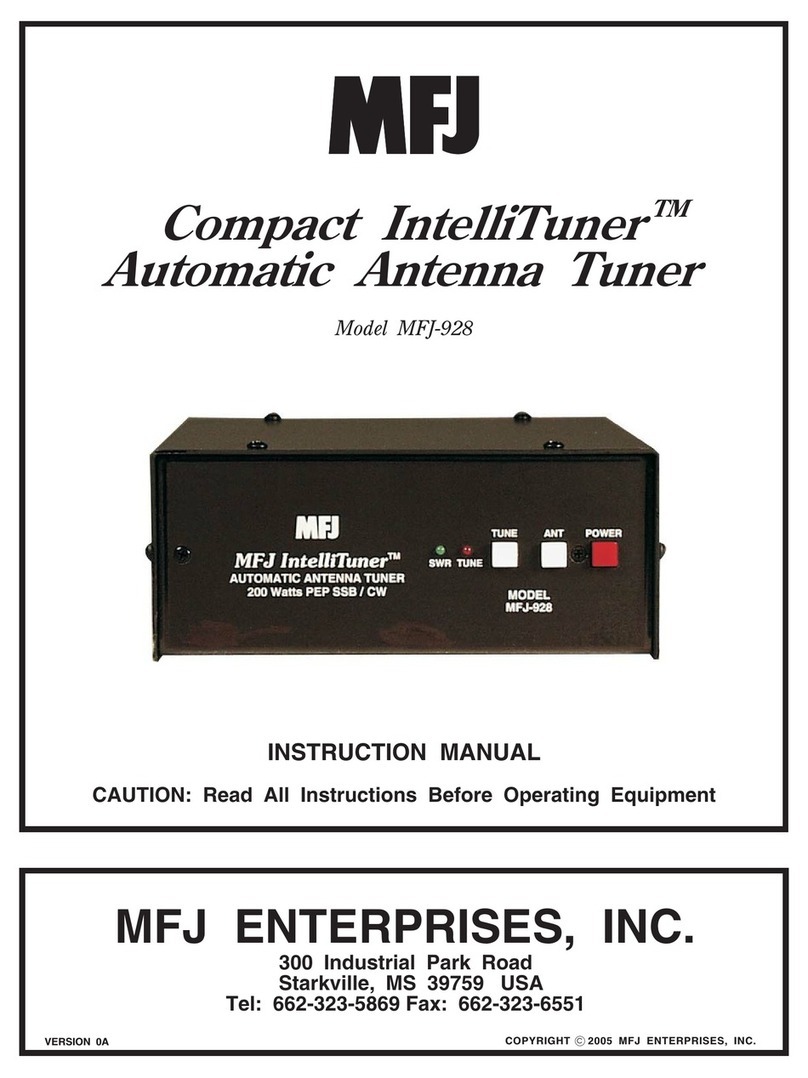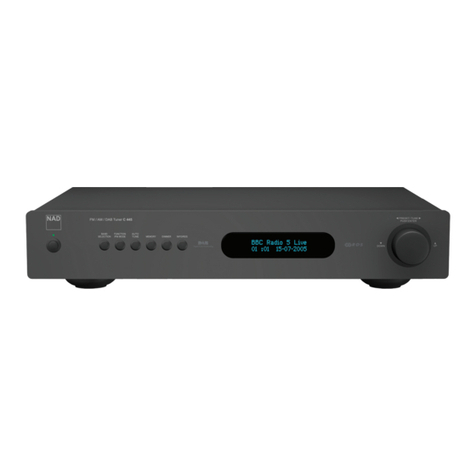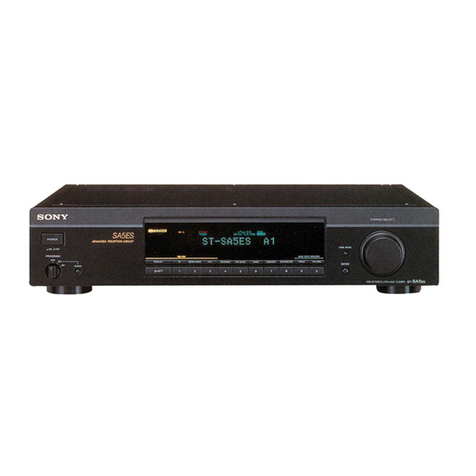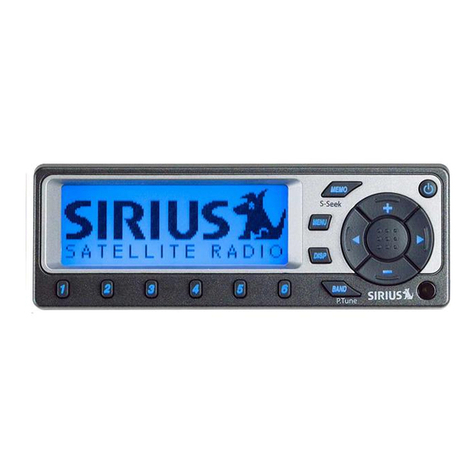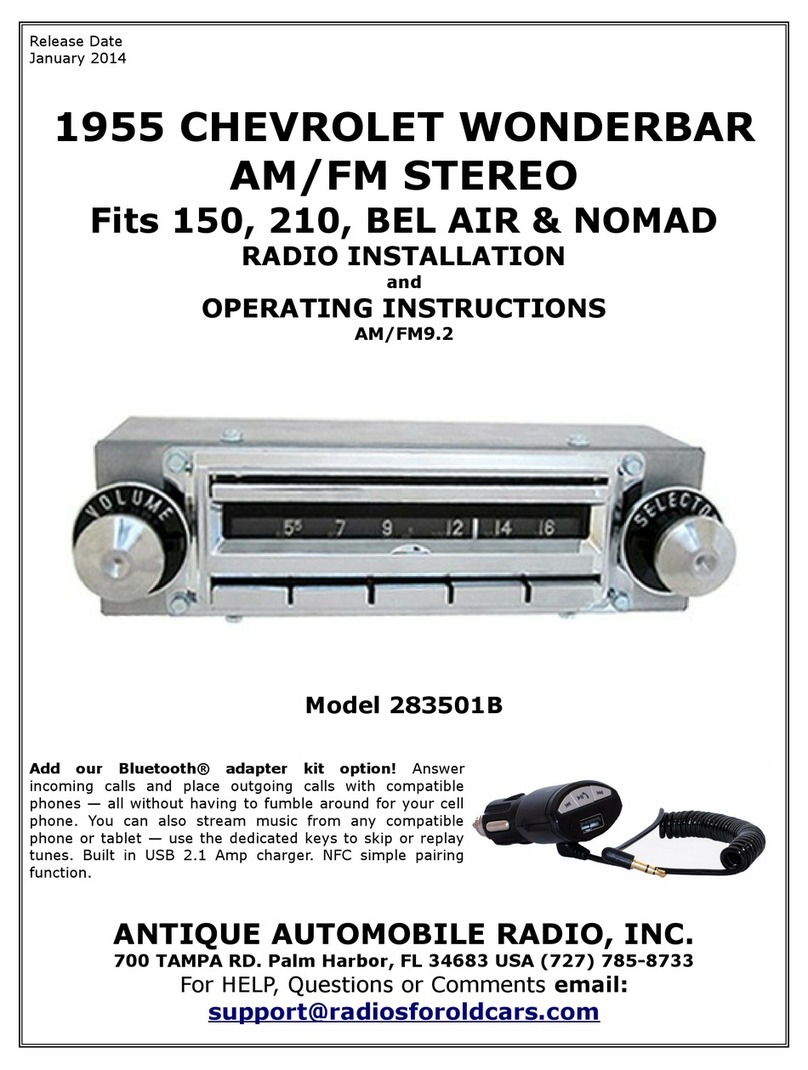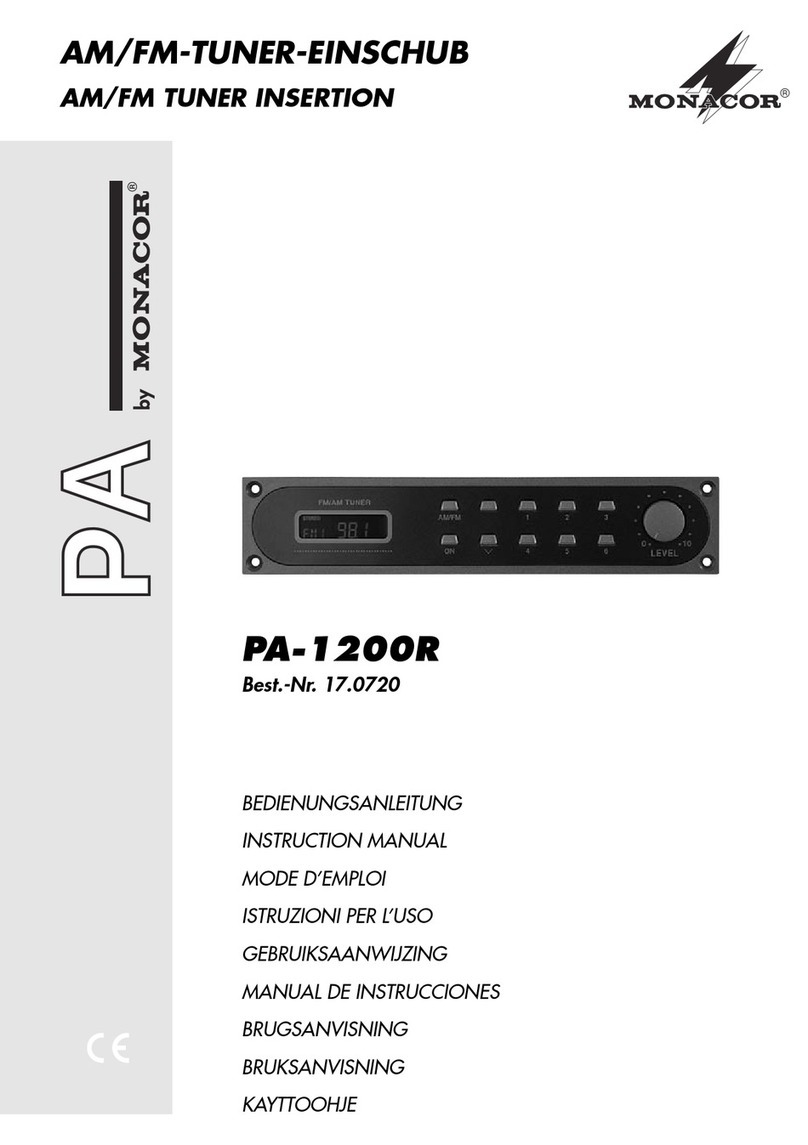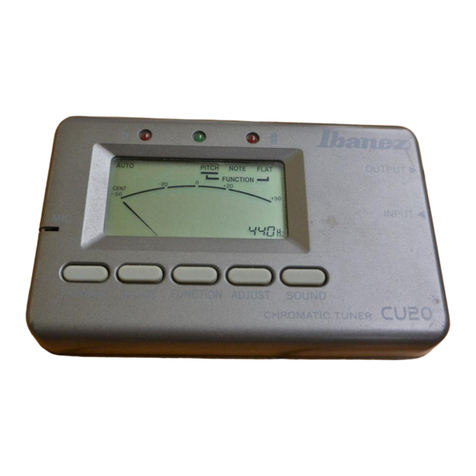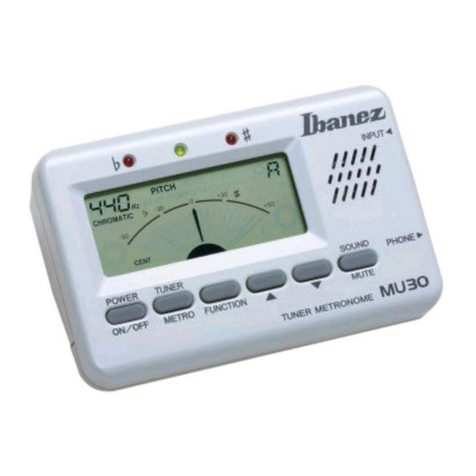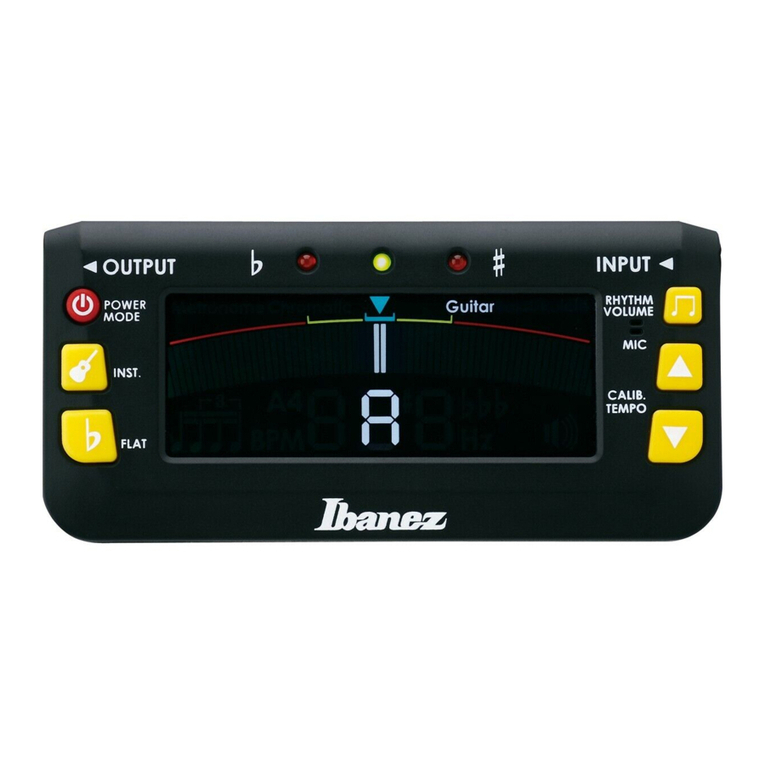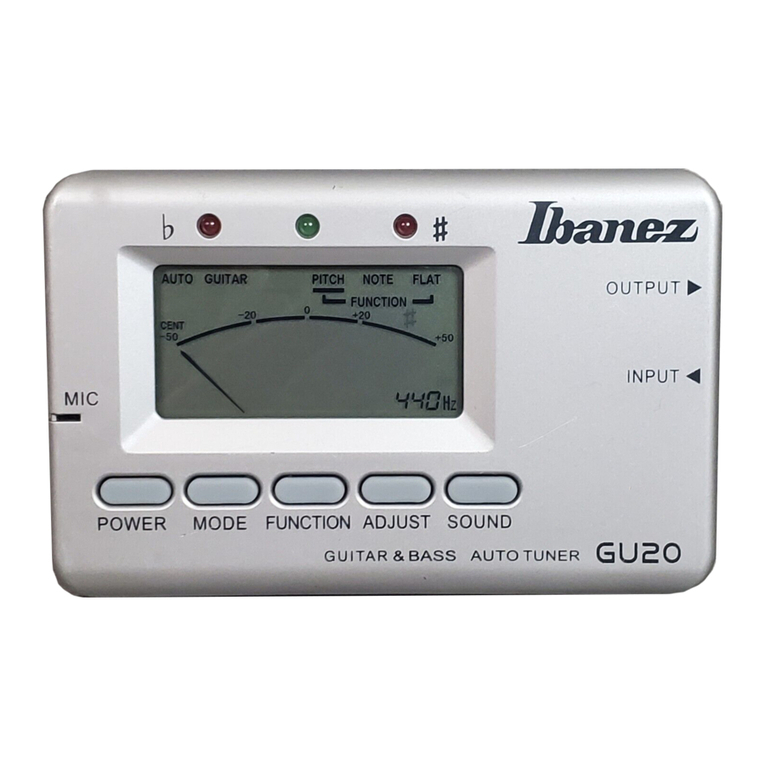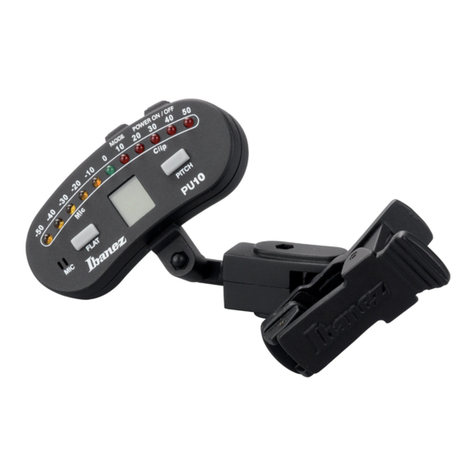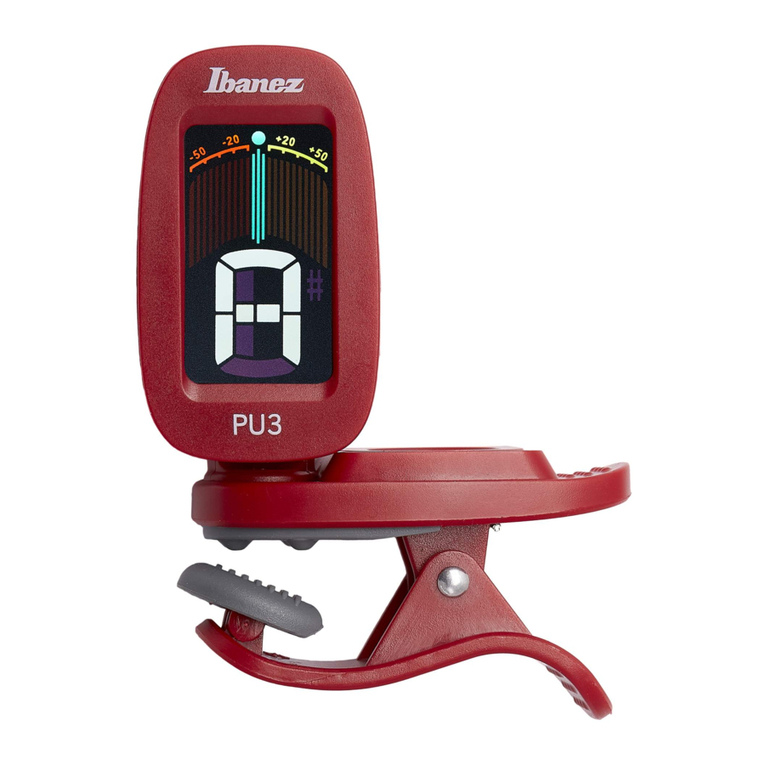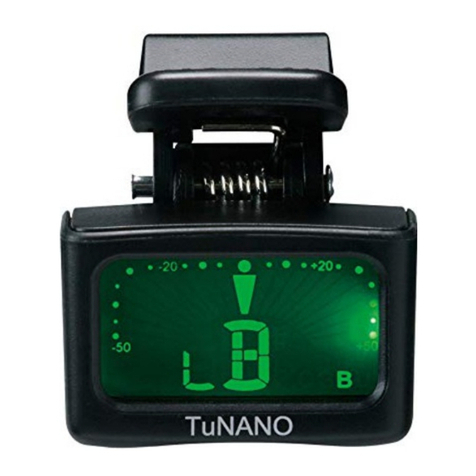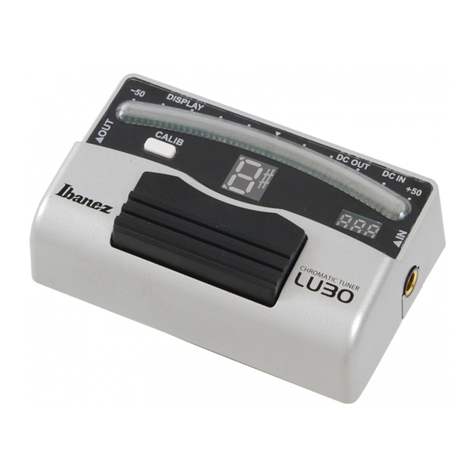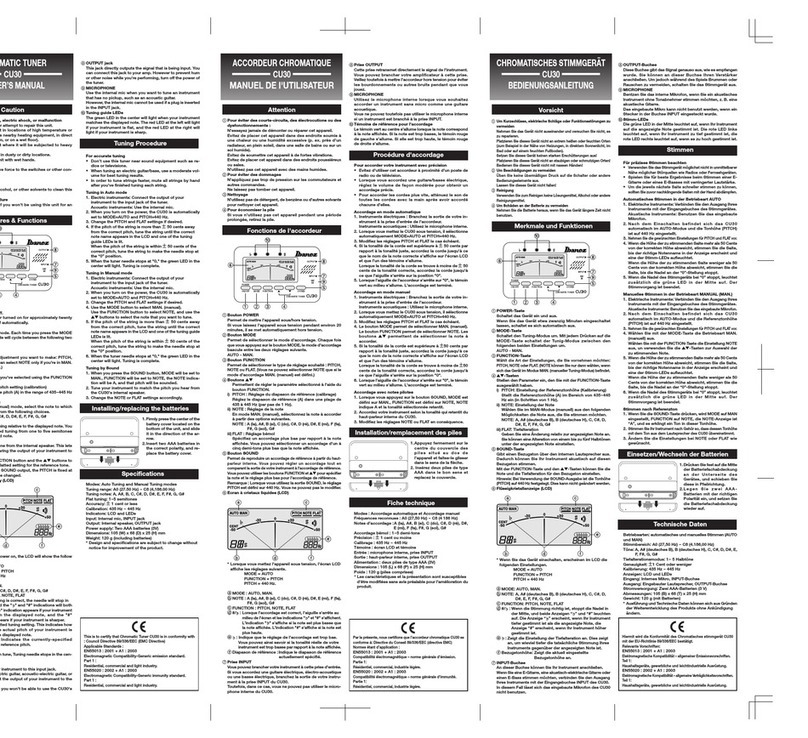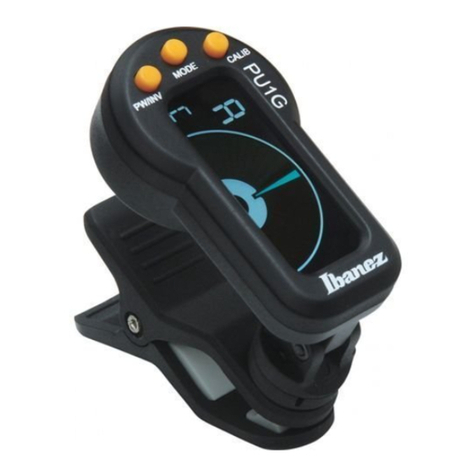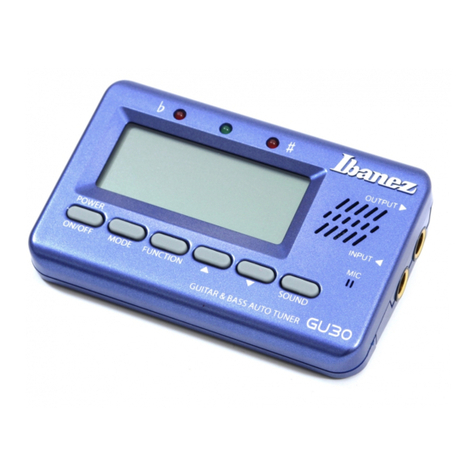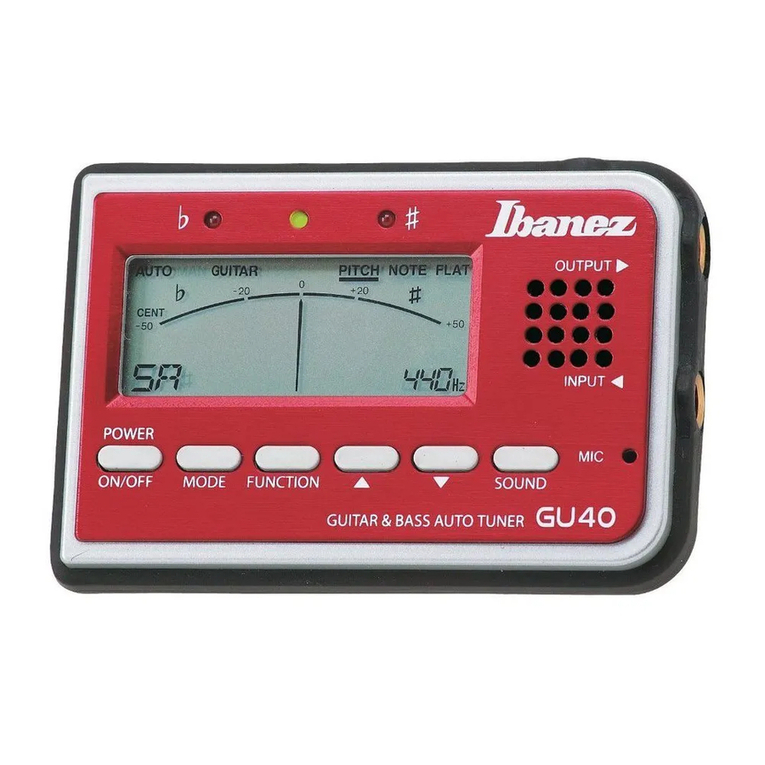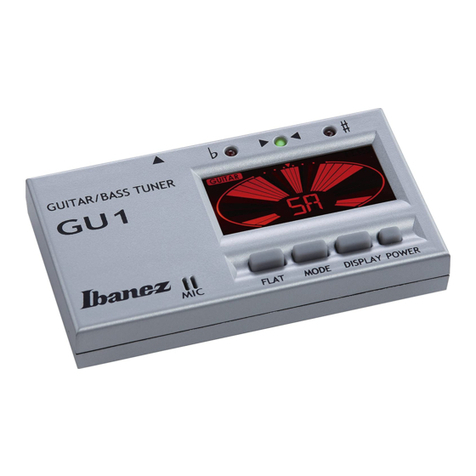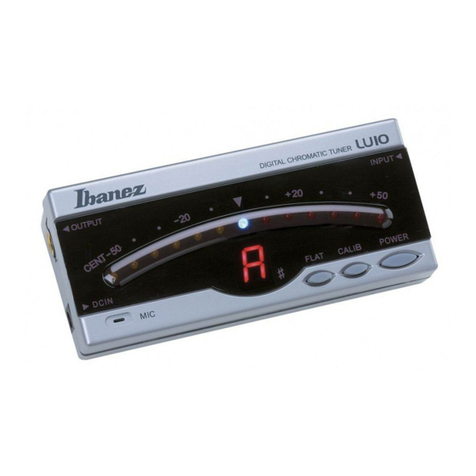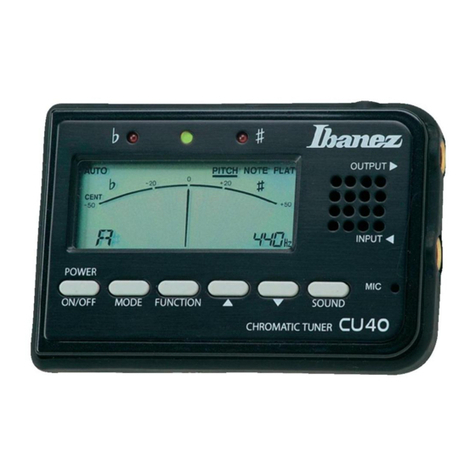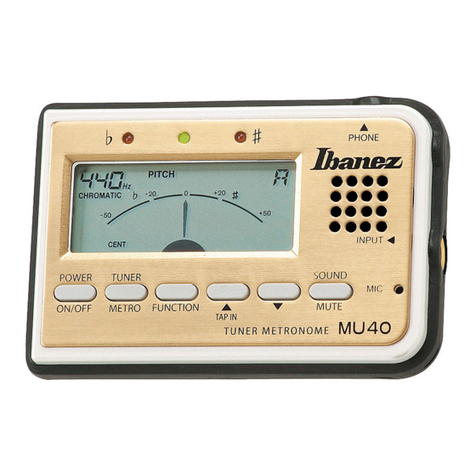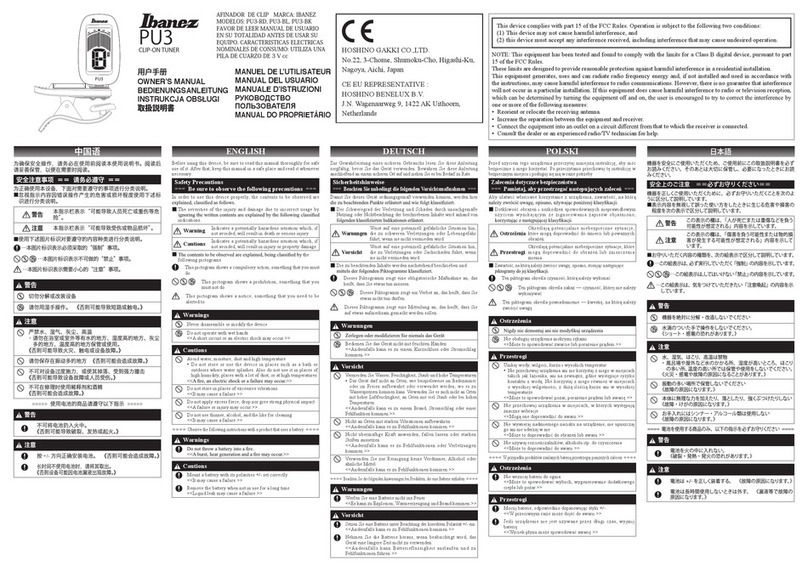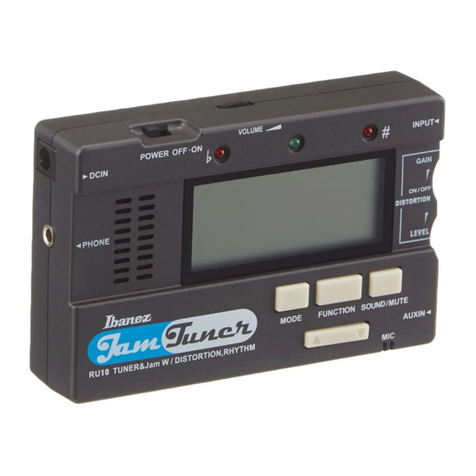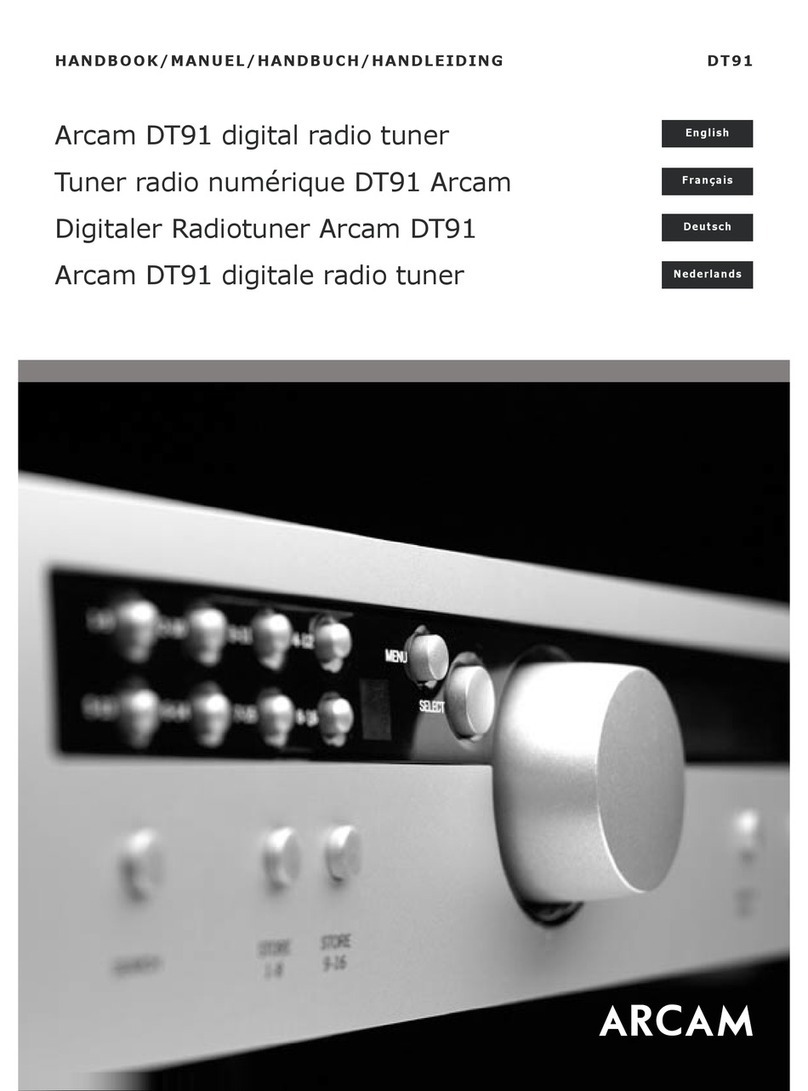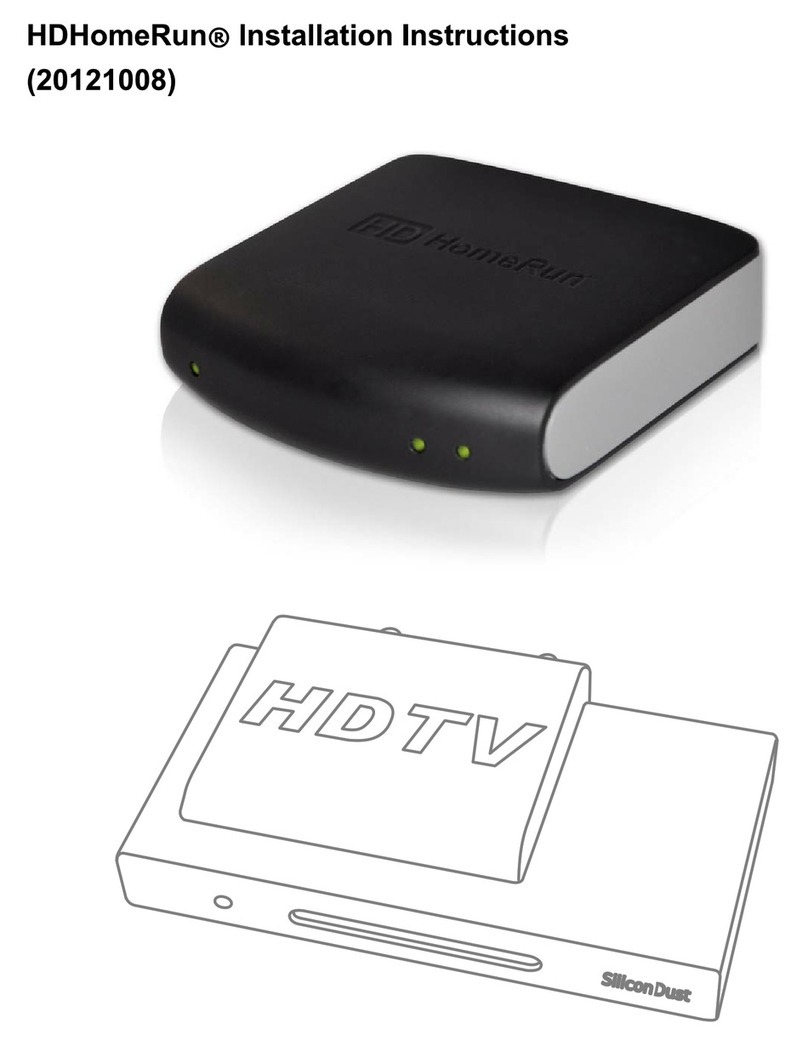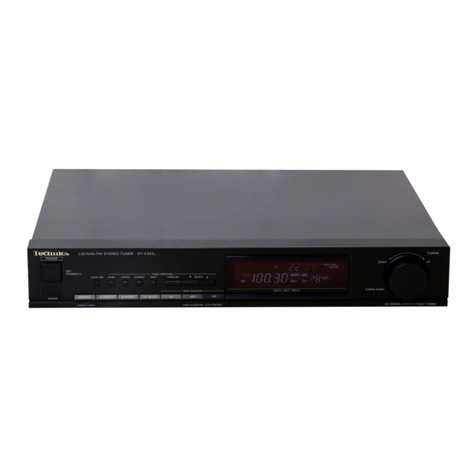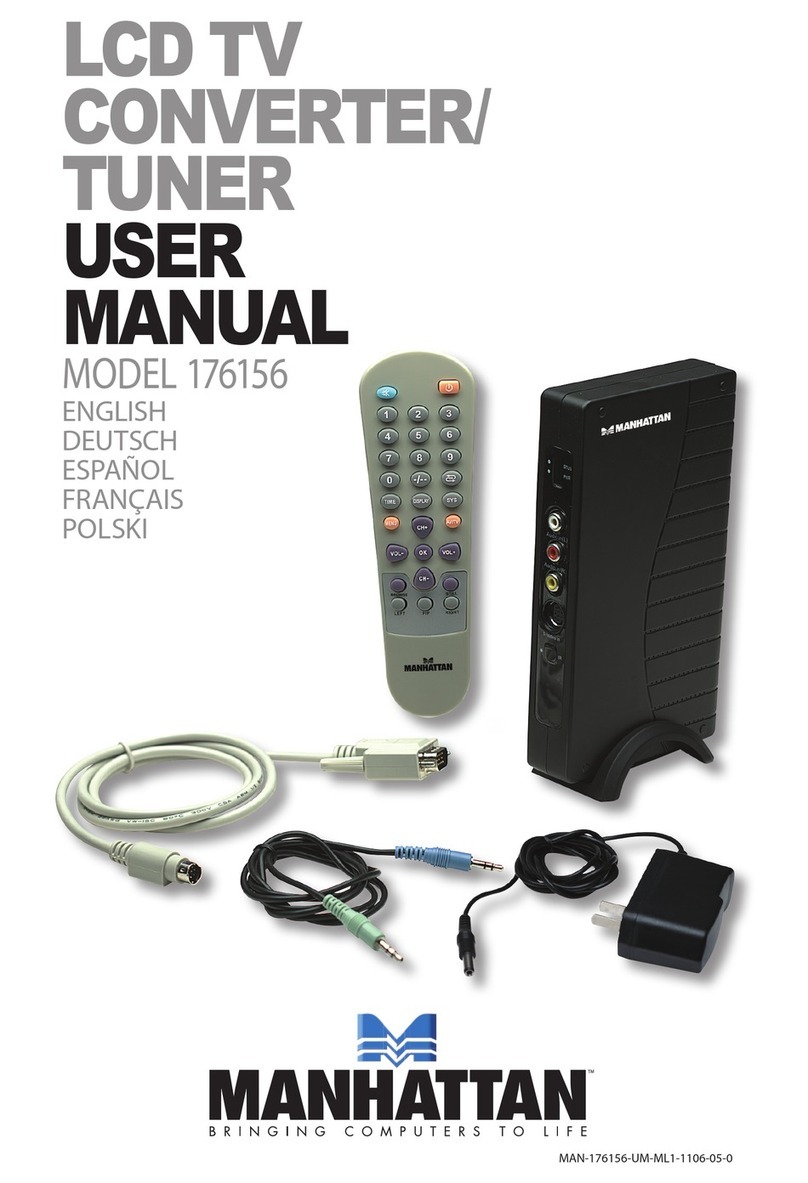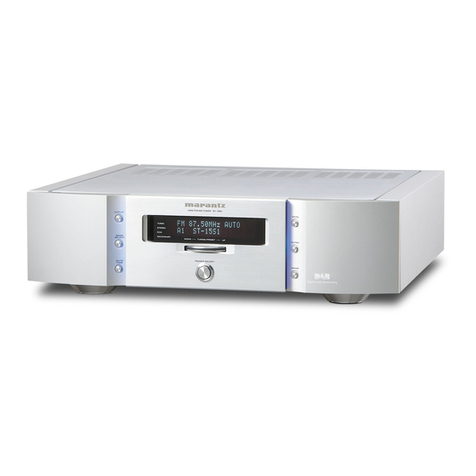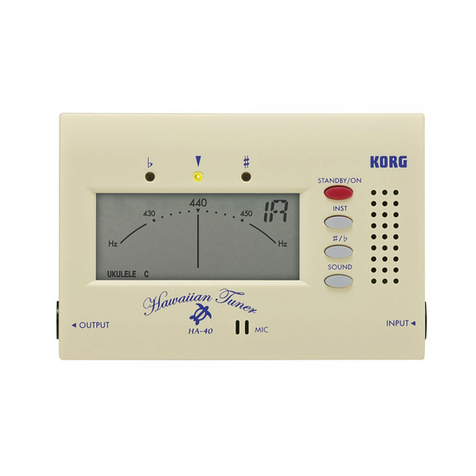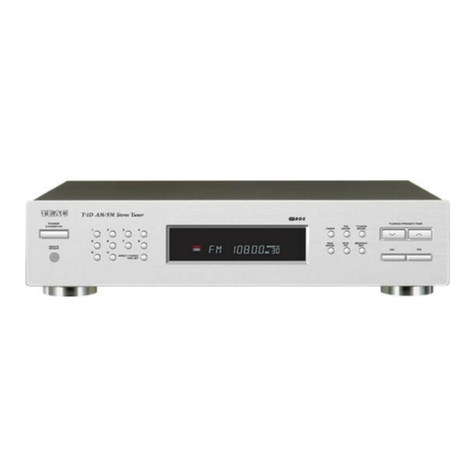CHROMATISCHES BODEN-STIMMGERÄT
LU20
BEDIENUNGSANLEITUNG
Attention
1Pour éviter des courts-circuits, des
électrocutions oudes dysfonctionnements :
N'essayez jamais de démonter ou réparer cet
appareil.
Evitez de placer cet appareil dans des
endroits soumis à une chaleur ou une
humidité excessive (p. ex. près d'un
radiateur, en plein soleil, dans une salle de
bains ou sur un sol humide).
Evitez de soumettre cet appareil à de fortes
vibrations.
Evitez de placer cet appareil dans des
endroits poussiéreux ou sales.
N'utilisez pas cet appareil avec des mains
humides.
2
Pour éviter des dommages
N'appliquez pas trop de pression sur les
commutateurs et autres commandes.
Ne laissez pas tomber cet appareil.
3
Nettoyage
N'utilisez pas de détergent, de benzène ou
d'autres solvants pour nettoyer cet appareil.
4
Pour économiser la pile
Si vous n'utilisez pas cet appareil pendant
une période prolongée, retirez la pile.
Fonctionnement
1 L'appareil est mis automatiquement sous ten-
sion lorsque vous insérez une fiche dans la
prise d'entrée (Input).
2 Lorsque vous appuyez sur le bouton CALIB,
le premier chiffre qui s'affiche indique le dia-
pason sur lequel l'accordeur LU20 est réglé,
c'est-à-dire : 6 = 436 Hz, 7 = 437 Hz···., 0 =
440z = 0 ···. jusqu'à 5 = 445 Hz .
Si vous appuyez plusieurs fois sur le bouton
CALIB, vous pouvez augmenter la valeur de
1 Hz à la fois (l'accordeur LU20 est réglé sur
la valeur par défaut de A = 440 Hz à la sortie
d'usine).
3
Lorsque vous appuyez sur le bouton FLAT en
premier, aucune information ne s'affiche sur
l'indicateur. Mais si vous appuyez de nouveau,
le segment supérieur s'allume, indiquant un
bémol ( ). Si vous appuyez plusieurs fois sur
le bouton FLAT, vous pouvez changer la hau-
teur de l'accord, comme indiqué ci-dessous.
4
Transmettez le signal de votre guitare dans la
prise d'entrée (Input). Si vous connectez la prise
de sortie sans effets (Dry out) à un amplificateur,
la guitare reste branchée à l'amplificateur même
si vous ne l'accordez pas.
Si vous préférez ne pas envoyer en sortie un
son de votre amplificateur pendant l'accord,
utilisez le signal depuis la prise de sortie (Out-
put) de votre amplificateur. Vous pourrez
activer/désactiver le signal à l'aide du
commutateur au pied.
5 Pour commencer à accorder votre guitare,
jouez une note ; le nom de la note la plus
proche s'affiche sur l'indicateur. Accordez-la
jusqu'à ce que la note correcte s'affiche. Puis,
accordez-la de manière plus précise en
ACCORDEUR CHROMATIQUE AU PIED
LU20
MANUEL DE L’UTILISATEUR
fonction des témoins indicateurs. Le côté
jaune indique que la hauteur correspond à
un bémol [
] et le côté rouge indique que la
hauteur est aiguë [#]. Une fois la guitare
accordée correctement, le témoin indicateur
bleu central s'allume.
6 Utilisation de l'adaptateur secteur
Si vous souhaitez utiliser un adaptateur
secteur, choisissez uniquement le modèle
Ibanez AC109. Si vous utilisez un autre
adaptateur secteur, vous risquez
d'endommager l'accordeur LU20 ou de
provoquer des dysfonctionnements.
Connexions
Utilisation des piles
En utilisation normale, l'accordeur LU20
fonctionne environ 50 heures avec une pile.
Toutefois, si vous l'utilisez sur scène, nous vous
recommandons d'utiliser un adaptateur secteur.
1 Desserrez la vis du couvercle du logement
de pile situé au bas de l'accordeur LU20 et
retirez le couvercle en le faisant glisser.
2 Retirez la pile usagée de son emplacement.
3
Placez la pile neuve dans l'emplacement
correspondant (veillez à respecter la polarité
+/-).
4 Une fois la pile en place, remettez le couvercle
du logement de pile et resserrez la vis.
Remarque :
Retirez la pile si vous n'utilisez pas
l'accordeur LU20 pendant une
période prolongée. Vous éviterez
ainsi des accidents tels qu'une fuite
au niveau de la pile.
Fiche technique de l'accordeur LU20
Puissance Pile 006P 9 V ou adaptateur
secteur Ibanez AC109
Consommation 15 mA maximum
Fréquences
reconnues
C1 (32,70 Hz)--B5 (987,77 Hz)
Précision +/-1 cent
Calibrage 436 Hz--445 Hz
Prise Entrée, Sortie, Sortie sans
effets, Alimentation c.c.
Dimensions 145 (L) x 45 (H) x 82 (P) mm
Poids 430 g
*
L'aspect et les caractéristiques sont susceptibles
d'être modifiés sans avis préalable pour
l'amélioration du produit.
Caution
1
To avoid short circuit, electric shock, or mal-
function
Do not disassemble or attempt to repair this
unit.
Do not place this unit in locations of high tem-
perature or high humidity (such as nearby
heating equipment, in direct sunlight, in a
bathroom, or on a wet floor).
Do not place this unit where it will be sub-
jected to heavy vibration.
Do not place this unit in dusty or dirty loca-
tions.
Do not operate this unit with wet hands.
2
To avoid damage
Do not apply excessive force to the switches
or other controls.
Do not drop this unit.
3
Cleaning
Do not use thinner, alcohol, or other solvents
to clean this unit.
4
To prevent battery failure
Remove the battery if you won't be using this
unit for an extended time.
Operation
1 The power will turn on automatically when you
insert a plug into the Input jack.
2 When you press the CALIB button, the first
digit of the pitch currently LU20 is set, will be
displayed in the indicator. I.e., from 436Hz =
6, 437Hz =7···., 440Hz = 0 ···. up to 445Hz = 5.
By pressing the CALIB button additional
times, you can increment the number by 1
Hz at a time. (LU20 is set to the default value
of A = 440 Hz when it is shipped out of the
factory.)
3 When you press the Flat button first, nothing
will be shown in the indicator. But when you
press it again, top segment will be lit, mean-
ing one flat (
). By pressing Flat button addi-
tional times, you can change the tuning pitch
as below.
4 Input the signal from your guitar into the In-
put jack. By connecting the Dryout jack and
an amplifier, the guitar will stay connected
with the amp even if you are not tuning.
If you prefer not to output sound out of your
amplifier during tuning, use the signal from
Output jack for your amp. You will be able to
switch on/off the signal by the Foot Switch.
5 To start tuning your guitar, play a note; the
name of the closest note will be shown in the
indicator. Tune so that the correct note is
shown. Then, tune more precisely according
to the LEDs. The yellow side indicates that the
pitch is flat [
], and the red side indicates that
the pitch is sharp [#]. When the tuning is cor-
rect, the center blue LED will be lit.
CHROMATIC PEDAL TUNER
LU20
OWNER’S MANUAL
6 Using the AC adaptor
If you would like to use an AC adaptor, use
only the Ibanez AC109. Using any other AC
adaptor may cause damage to LU20 or oper-
ate incorrectly.
Connections
Using batteries
In normal use, the LU20 will operate for approxi-
mately 50 hours on battery. However if you're
using it on stage, we recommend that you use
an AC adaptor.
1 Loosen the screw of the cover of the battery
compartment at the bottom of LU20, and slide
the cover off.
2 Detach the old battery from the battery snap.
3 Attach the new battery to the battery snap.
(Make sure the correct +/- polarity.)
4 After setting the battery in place, put the bat-
tery cover back, and tighten the screw.
Note : Remove the battery if you won't be using
the LU20 for an extended period of time.
This will prevent accidents such as bat-
tery leakage.
LU20 specifications
Power 9V 006P battery or
Ibanez AC109 AC adaptor
Current
consumption Maximum 15 mA
Tuning range
C1 (32.70 Hz)--B5 (987.77 Hz)
Accuracy +/-1 cent
Calibration 436 Hz--445 Hz
Jack Input, Output, Dryout,
DC power
Dimensions 145 (W) x 45 (H) x 82 (D) mm
Weight 430g
* Appearance and specifications are subject to
change without notice for improvement.
Vorsicht
1
Um Kurzschlüsse, elektrische Schläge oder
Funktionsstörungen zu vermeiden
Nehmen Sie das Gerät nicht auseinander und
versuchen Sie nicht, es zu reparieren.
Platzieren Sie dieses Gerät nicht an extrem
heißen oder feuchten Orten (zum Beispiel in
der Nähe von Heizungen, in direktem
Sonnenlicht, im Bad oder auf einem feuchten
Fußboden).
Setzen Sie dieses Gerät keinen starken
Erschütterungen aus!
Platzieren Sie dieses Gerät nicht an
staubigen oder schmutzigen Orten!
Bedienen Sie dieses Gerät nicht mit nassen
Händen!
2
Um Beschädigungen zu vermeiden
Üben Sie keine übermäßigen Druck auf die
Schalter oder andere Bedienungselemente
aus.
Lassen Sie dieses Gerät nicht fallen!
3
Reinigung
Verwenden Sie zum Reinigen keine
Lösungsmittel, Alkohol oder andere
Reinigungsmittel.
4
Um Schäden an der Batterie zu vermeiden
Nehmen Sie die Batterie heraus, wenn Sie
das Gerät längere Zeit nicht benutzen.
Bedienung
1
Das Gerät schaltet sich automatisch ein, wenn
Sie einen Stecker an der Eingangsbuchse (In-
put) anschließen.
2
Wenn Sie die Taste CALIB drücken, erscheint
die letzte Ziffer der momentan im LU20
eingestellten Bezugstonhöhe in der Anzeige.
D. h. bei 436 Hz = 6, bei 437 Hz = 7
···
, bei 440
Hz = 0
···
und bei 445 Hz = 5.
Indem Sie die Taste CALIB mehrfach drücken,
können Sie die Bezugstonhöhe in Schritten
von 1 Hz erhöhen. (Das LU20 ist ab Werk auf
den Wert A = 440 Hz voreingestellt.)
3 Wenn Sie zuerst die Taste Flat (vermindert)
drücken, wird nichts angezeigt. Wenn Sie die
Taste nochmals drücken, leuchtet das
oberste Segment, was eine Verminderung um
einen Halbton bedeutet ( ). Indem Sie die
Taste Flat mehrfach drücken, können Sie die
Stimmungstonhöhe wie folgt ändern.
4
Führen Sie das Signal von Ihrer Gitarre zur
Eingangsbuchse (Input). Wenn Sie die
Direktausgangsbuchse (Dryout) mit Ihrem
Verstärker verbinden, bleibt die Gitarre mit dem
Amp auch dann verbunden, wenn Sie sie nicht
stimmen.
Wenn Sie stimmen möchten, ohne dass die
Gitarre über den Verstärker erklingt, führen
Sie das Signal von der Ausgangsbuchse (Out-
put) zu Ihrem Amp. In diesem Fall können Sie
das Signal mit dem Fußschalter ein- und
ausschalten.
5 Um Ihre Gitarre zu stimmen, spielen Sie
zunächst einen Ton. Der Name der Note, die
diesem Ton am nächsten liegt, erscheint in
der Anzeige. Stimmen Sie die Saite, bis die
richtige Note angezeigt wird. Stimmen Sie
dann genauer mithilfe der LEDs. Die gelbe
Seite bedeutet, dass die Tonhöhe zu niedrig
ist
[
]
, die rote Seite bedeutet, dass die
Tonhöhe zu hoch ist [#]. Bei korrekter
Stimmung leuchtet die mittlere, blaue LED
auf.
6 Verwenden des Netzadapters
Wenn Sie einen Netzadapter anschließen
möchten, verwenden Sie nur den AC109 von
Ibanez. Die Verwendung eines anderen
Netzadapters kann Schäden am LU20 oder
Fehlfunktionen verursachen.
Anschlüsse
Verwenden von Batterien
Bei normalem Gebrauch läuft das LU20 etwa 50
Stunden mit Batterie. Wenn Sie es jedoch bei
Auftritten verwenden, empfehlen wir den Einsatz
eines Netzadapters.
1 Lösen Sie die Schraube der
Batteriefachabdeckung unten am LU20, und
öffnen Sie die Abdeckung.
2 Nehmen Sie die alte Batterie aus der
Halterung heraus.
3 Befestigen Sie die neue Batterie an der
Halterung. Achten Sie auf korrekte Polarität
(+/-).
4 Nachdem Sie die neue Batterie eingelegt
haben, schließen Sie die
Batteriefachabdeckung wieder und ziehen
Sie die Schraube fest.
Hinweis: Nehmen Sie die Batterie heraus, wenn
Sie das LU20 für längere Zeit nicht
benutzen. Dies vermeidet Schäden
durch eine auslaufende Batterie.
Technische Daten LU20
Stromversorgung 9V-Batterie der Größe
006P oder Netzadapter
AC109 von Ibanez
Stromverbrauch Maximal 15 mA
Stimmbereich C1 (32,70 Hz) bis B5
(987,77 Hz)
Genauigkeit +/-1 Cent
Kalibrierung 436 Hz bis 445 Hz
Buchsen Input (Eingang), Output
(Ausgang), Dryout
(Direktausgang),
DC (Spannungsversorgung)
Abmessungen 145 (B) x 45 (T) x 82 (H) mm
Gewicht 430 g
* Erscheinungsbild und technische Daten können
sich aus Gründen der Weiterentwicklung ohne
Ankündigung ändern.
This is to certify that Chromatic Tuner LU20 is in
conformity with : Council Directive 89/336/EEC
(EMC Directive)
Applicable Standards :
EN55013 : 2001 + A1 : 2003
Electromagnetic Compatibility-Generic emission
standard.
Part 1 :
Residential, commercial and light industry.
EN55020 : 2002 + A1 : 2003
Electromagnetic Compatibility-Generic immunity
standard.
Part 1 :
Residential, commercial and light industry.
